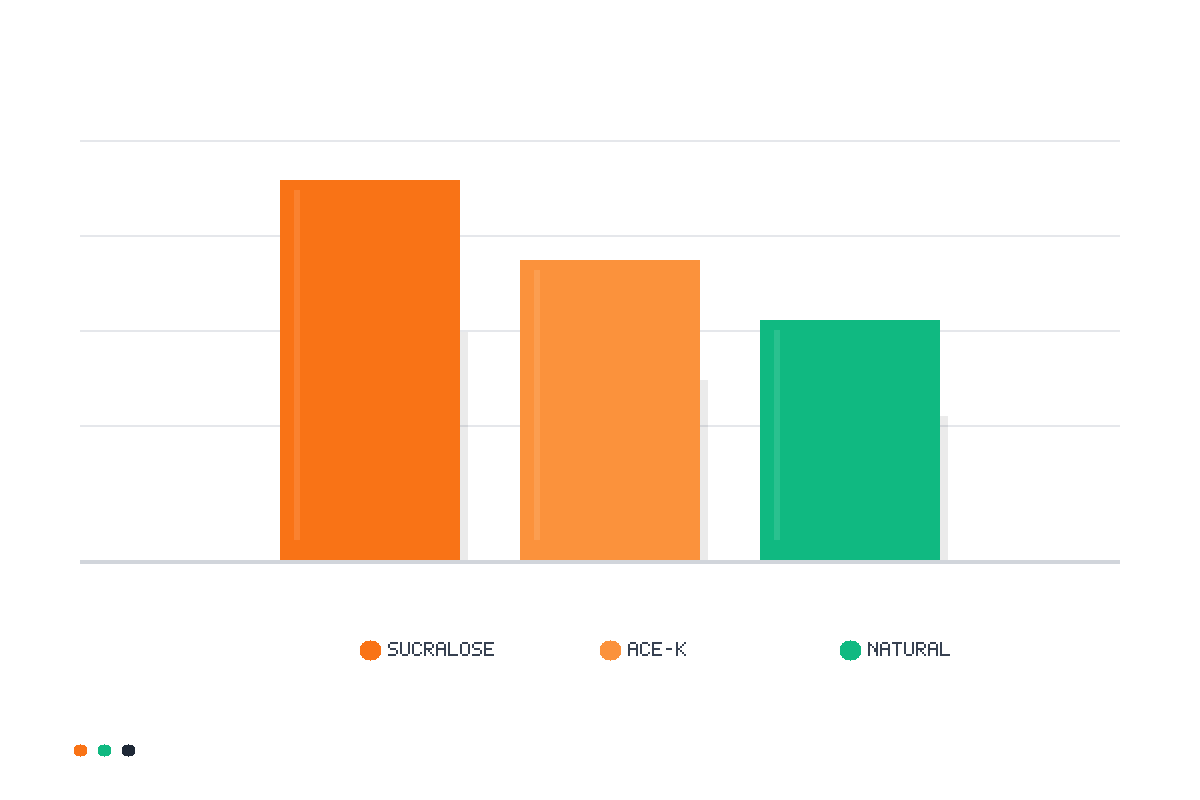Natural vs Artificial Sweeteners in Protein Powder: What Our Data Shows
A data-driven guide to sucralose, Ace‑K, stevia, and monk fruit in protein powders—taste, tolerance, and how to choose
Natural vs Artificial Sweeteners in Protein Powder: What Our Data Shows
When you’re comparing protein powders, taste often makes or breaks consistency. Sweeteners are the secret lever brands pull to create that “milkshake flavor” without sugar—and they’re in most formulas you’ll see. After analyzing 579 protein products in our database, a clear pattern emerges: artificial sweeteners dominate the market today, while natural options are steadily on the rise.
This guide breaks down what’s actually in your scoop, the trade-offs between artificial vs natural sweeteners, and how to pick a product that fits your goals—whether you want the cleanest label possible or the best-tasting shake for daily use.

Market Snapshot: What’s Really Used
From our ingredient analysis:
- Sucralose is the most common artificial sweetener we see—present in 194 products
- Acesulfame potassium (Ace‑K) appears alongside sucralose in 134 products, usually as a flavor stabilizer
- “Natural” high-intensity sweeteners (stevia, monk fruit) appear across many clean-label and sugar-free products, often paired with flavor modulators to reduce aftertaste
Three reasons artificial sweeteners remain popular with manufacturers:
- Tiny amounts deliver strong sweetness without added sugar
- Stable in heat and across shelf life
- Predictable taste when blended with strong flavors (chocolate, vanilla)
Natural options, especially modern stevia and monk fruit extracts, have improved significantly. They’re now common in premium sugar-free or “no artificial ingredients” formulas focused on label transparency and gentler digestion.
What Sweeteners Actually Do in a Formula
Sweeteners do more than sweeten. In flavored protein powders they also:
- Mask protein’s natural bitterness and any mineral notes
- Smooth flavor transitions (first taste → mid-palate → finish)
- Interact with thickeners/emulsifiers to influence mouthfeel
- Support consistency across batches and flavors
The result: a shake you’ll actually drink every day. That matters more than any single feature if your goal is consistent protein intake.
Artificial vs Natural: The Practical Differences
Artificial (Sucralose, Ace‑K)
Pros:
- Highly sugar-like sweetness with very low usage rates
- Stable during processing and storage
- Widely available and cost-effective
Trade-offs:
- Some users report bitterness in the finish (especially without flavor pairing)
- Taste fatigue for some palates over time
- Preference-based avoidance by “clean label” consumers
Natural (Stevia, Monk Fruit)
Pros:
- Plant-derived; aligns with clean label preferences
- Rapidly improving taste profiles with modern extraction
- Often paired with cocoa/vanilla to deliver balanced flavor
Trade-offs:
- Subtle licorice or fruity notes depending on extract quality
- More formulation work to reduce aftertaste
- Premium SKUs can cost more
Label Decoder: What Names to Look For
- Sucralose → often appears near the end of the list (very small amounts)
- Acesulfame potassium → also listed as Ace‑K
- Stevia → may appear as stevia extract, rebaudioside A (Reb A), or steviol glycosides
- Monk fruit → luo han guo extract or mogrosides
If a product claims “no artificial sweeteners,” flip the tub and check for stevia/monk fruit, sugar alcohols (erythritol, xylitol), or unflavored options with zero sweeteners.
Taste, Texture, and Aftertaste: What to Expect
- Chocolate flavors hide high-intensity sweeteners best; light/fruity flavors are less forgiving
- Natural sweeteners benefit from salt, cocoa, or vanilla to round off edges
- Gums/emulsifiers can improve mouthfeel, but some users prefer “no gums” formulas for digestion
- Unflavored whey (no sweeteners) mixes well into smoothies or oatmeal if you want total control
Digestion and Tolerance
- Sugar alcohols (erythritol, xylitol, maltitol) can cause bloating in higher amounts—dose matters
- Many people tolerate sucralose/Ace‑K without issues; others prefer to avoid them
- Stevia/monk fruit tend to be well tolerated but remain taste-preference dependent
- If you’re lactose-sensitive, whey isolate usually pairs best with any sweetener system
Brand Strategies We See
- “Mainstream flavor-first”: sucralose + Ace‑K, optimized for classic taste
- “Clean label premium”: stevia and/or monk fruit, fewer additives, higher ingredient transparency
- “Ultra-simple”: unflavored, no sweeteners, often paired with isolate and no gums
If you’re on a low-carb or diabetic-friendly diet, look for “sugar-free” variants that use high-intensity sweeteners instead of added sugars—and verify total carbs per serving.
How to Choose the Right Sweetener Profile
Ask yourself:
- What matters most—taste or label simplicity?
- Do I tolerate sugar alcohols?
- Am I sensitive to aftertaste or texture?
- Do I want isolate (less lactose) for easier digestion?
Practical picks:
- Want the cleanest label? Try stevia/monk fruit or unflavored isolate
- Want the most “classic milkshake” taste? Sucralose with Ace‑K in chocolate/vanilla
- Want blood-sugar-friendly without sugar alcohols? Look for stevia/monk fruit formulas
- Want full control? Go unflavored and sweeten in your blender
Explore current options on our comparison pages:
Quick Decision Framework
- Maximum taste familiarity → sucralose + Ace‑K
- Minimal ingredients → stevia/monk fruit or unflavored
- Sensitive stomach → isolate base; avoid heavy sugar alcohols
- Tight budget → mainstream sweetener combos typically cost less
FAQs
Q1. Are artificial sweeteners safe in protein powder?
Major regulators consider sucralose and Ace‑K safe at typical consumption levels. Some people prefer to avoid them due to taste preferences or personal philosophy. If you’re unsure, start with a stevia/monk fruit option or go unflavored.
Q2. Do natural sweeteners always taste better?
Not necessarily—taste is subjective and depends on flavor system quality. Modern stevia/monk fruit blends are much improved. Chocolate and vanilla blends tend to smooth any edges.
Q3. What if I want zero sweeteners?
Choose unflavored whey isolate or concentrate. Mix into smoothies, yogurt, or recipes where fruit, cocoa, or spices provide natural flavor.
Q4. Do sugar alcohols cause bloating?
They can at higher intakes, depending on the individual and type used. If you’re sensitive, favor stevia/monk fruit formulas or unflavored products.
Q5. Which form of whey pairs best with any sweetener?
Whey isolate typically digests easiest due to minimal lactose. If taste is king, concentrate often feels creamier—just check carbs/lactose on the label.
Bottom Line
Artificial sweeteners still dominate protein powders because they’re predictable, stable, and deliver familiar sweetness. Natural options continue to improve and now power many premium clean‑label products. The best choice is the one you’ll use daily: pick the flavor system you like, the digestion you tolerate, and the label you trust.
Consistency beats perfection. If a great-tasting shake helps you hit your protein target, that’s a win.
This guide is based on ingredient data from 579 protein products in our database. Always confirm current labels—formulas change—and consult healthcare providers for specific dietary needs.
